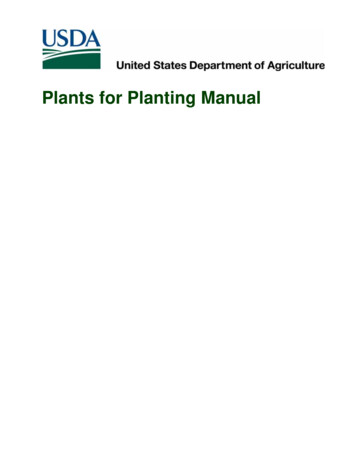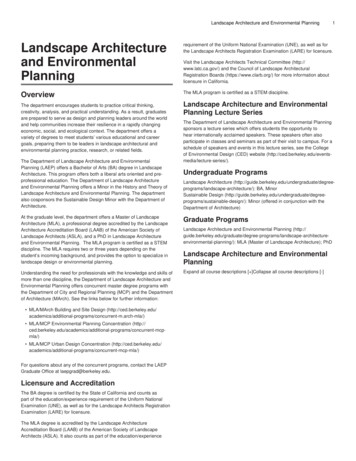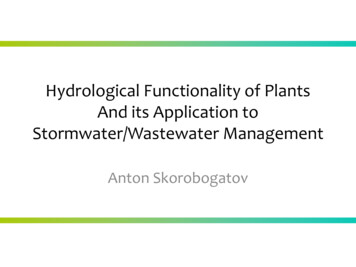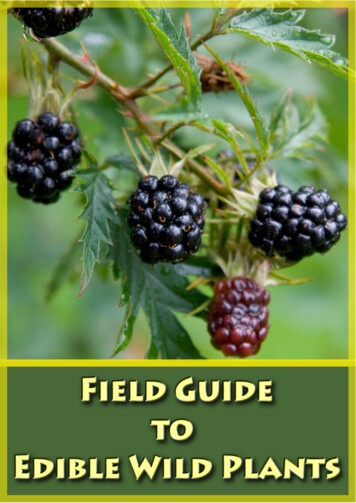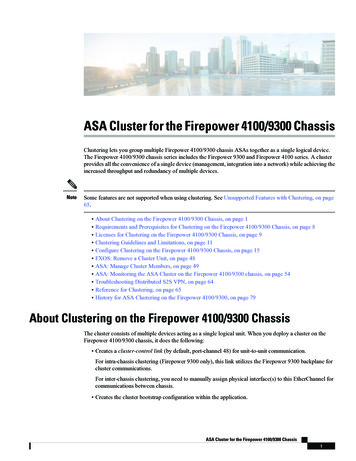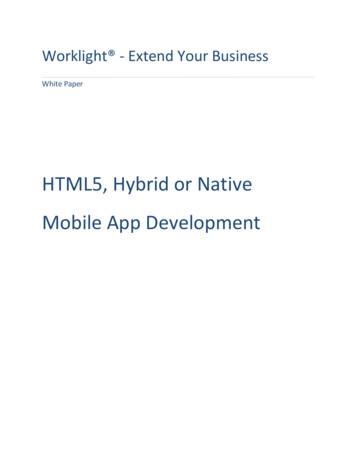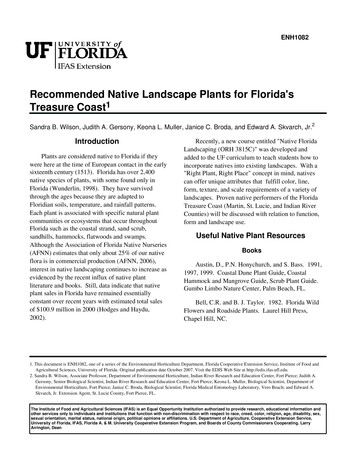
Transcription
ENH1082Recommended Native Landscape Plants for Florida'sTreasure Coast1Sandra B. Wilson, Judith A. Gersony, Keona L. Muller, Janice C. Broda, and Edward A. Skvarch, Jr.2IntroductionPlants are considered native to Florida if theywere here at the time of European contact in the earlysixteenth century (1513). Florida has over 2,400native species of plants, with some found only inFlorida (Wunderlin, 1998). They have survivedthrough the ages because they are adapted toFloridian soils, temperature, and rainfall patterns.Each plant is associated with specific natural plantcommunities or ecosystems that occur throughoutFlorida such as the coastal strand, sand scrub,sandhills, hammocks, flatwoods and swamps.Although the Association of Florida Native Nurseries(AFNN) estimates that only about 25% of our nativeflora is in commercial production (AFNN, 2006),interest in native landscaping continues to increase asevidenced by the recent influx of native plantliterature and books. Still, data indicate that nativeplant sales in Florida have remained essentiallyconstant over recent years with estimated total salesof 100.9 million in 2000 (Hodges and Haydu,2002).Recently, a new course entitled "Native FloridaLandscaping (ORH 3815C)" was developed andadded to the UF curriculum to teach students how toincorporate natives into existing landscapes. With a"Right Plant, Right Place" concept in mind, nativescan offer unique attributes that fulfill color, line,form, texture, and scale requirements of a variety oflandscapes. Proven native performers of the FloridaTreasure Coast (Martin, St. Lucie, and Indian RiverCounties) will be discussed with relation to function,form and landscape use.Useful Native Plant ResourcesBooksAustin, D., P.N. Honychurch, and S. Bass. 1991,1997, 1999. Coastal Dune Plant Guide, CoastalHammock and Mangrove Guide, Scrub Plant Guide.Gumbo Limbo Nature Center, Palm Beach, FL.Bell, C.R. and B. J. Taylor. 1982. Florida WildFlowers and Roadside Plants. Laurel Hill Press,Chapel Hill, NC.1. This document is ENH1082, one of a series of the Environmental Horticulture Department, Florida Cooperative Extension Service, Institute of Food andAgricultural Sciences, University of Florida. Original publication date October 2007. Visit the EDIS Web Site at http://edis.ifas.ufl.edu.2. Sandra B. Wilson, Associate Professor, Department of Environmental Horticulture, Indian River Research and Education Center, Fort Pierce; Judith A.Gersony, Senior Biological Scientist, Indian River Research and Education Center, Fort Pierce; Keona L. Muller, Biological Scientist, Department ofEnvironmental Horticulture, Fort Pierce; Janice C. Broda, Biological Scientist, Florida Medical Entomology Laboratory, Vero Beach; and Edward A.Skvarch, Jr. Extension Agent, St. Lucie County, Fort Pierce, FL.The Institute of Food and Agricultural Sciences (IFAS) is an Equal Opportunity Institution authorized to provide research, educational information andother services only to individuals and institutions that function with non-discrimination with respect to race, creed, color, religion, age, disability, sex,sexual orientation, marital status, national origin, political opinions or affiliations. U.S. Department of Agriculture, Cooperative Extension Service,University of Florida, IFAS, Florida A. & M. University Cooperative Extension Program, and Boards of County Commissioners Cooperating. LarryArrington, Dean
Recommended Native Landscape Plants for Florida's Treasure CoastBirr, R.E. 1992. Growing and PropagatingShowy Native Woody Plants. The University ofNorth Carolina Press, Chapel Hill & London.Tomlinson, P.B. 2001. The Biology of TreesNative to Tropical Florida. Harvard Printing andPublication Services, Allston, Mass.Daniels, J.C. 2000. Your Florida Guide toButterfly Gardening. University Press of Florida,Gainesville, FL.Wasowski, S. and A. Wasowski. 1994.Gardening with Native Plants of the South. TaylorPublishing Co., Dallas, Texas.Dehgan, B. 1998. Landscape Plants forSubtropical Climates. University Press of Florida,Gainesville, FL.Walton, D. and L. Schiller. 2007. NaturalFlorida Landscaping. University Press, Sarasota,FL.Haehle, R.G. and J. Brookwell. 1999. NativeFlorida Plants. Gulf Publishing Company, Houston,TX.Wunderlin, R.P. 1998. Guide to the VascularPlants of Florida. University Press of Florida,Gainesville, FL.Hightshoe, G.L. 1998. Native Trees, Shrubs, andVines for Urban and Rural America: A PlantingDesign Manual for Environmental Designers. JohnWiley & Sons, Inc., New York.Yarlett, L.L. 1996. Common Grasses of Floridaand the Southeast. The Florida Native Plant Society,Spring Hill, FL.Huegel, C.N. 1995. Florida Plants for Wildlife.Florida Native Plant Society, Orlando, FL.Nellis, D.W. 1994. Seashore Plants of SouthFlorida and the Caribbean. Pineapple Press, Inc.Sarasota, FL.Nelson, G. 1994. The Trees of Florida.Pineapple Press, Inc. Sarasota, FL.Nelson, G. 1996. The Shrubs & Woody Vinesof Florida. Pineapple Press, Inc., Sarasota, FL.Nelson, G. 2000. The Ferns of Florida.Pineapple Press, Inc., Sarasota, FL.Nelson, G. 2003. Florida's Best NativeLandscape Plants. University Press of Florida,Gainesville.Osorio, R. 2001. A Gardener's Guide toFlorida's Native Plants. University Press of Florida,Gainesville, FL.Songdah, H. and C. Leon. 2007. The Art ofSouth Florida Gardening. Pineapple Press, Inc.Sarasota, FL.Suncoast Native Plant Society. 1997. The RightPlants for Dry Places. Great Outdoors PublishingCo., St. Petersburg, FL.2Useful Native Plant WebsitesAssociation of Florida Native Nurseries. 2005.Contains wholesale and retail plant listings, news andevents, and useful know the difference' articles.http://www.afnn.org/search afnn.asp?n 22Cowley, M. 1997-2005. Florida's native plants.Website contains useful information about nativegardening, plants for birds, and butterfly plants.http://www.nsis.org/garden.Florida Native Plants. 2001-2007. Useful beforeand after pictures of native landscape designs andvarious articles and essays about native tmlFlorida Wildflowers Growers Cooperative.2003. Informative brochures, planting information,seed availability, and photo gallery.http://www.floridawildflowers.comGardening with Florida Yards andNeighborhoods. 2007. Links to UF/IFASpublications, endangered species, edible plants andlandscaping. http://cfyn.ifas.ufl.edu/native.htmlNative Plants Journal. A forum for dispersingpractical information about planting and growingnative plants for conservation, restoration,reforestation, and landscaping. Indiana University
Recommended Native Landscape Plants for Florida's Treasure CoastPress, Bloomington, IN.http://www.nativeplantnetwork.org.Sources to Obtain Native Plants forthe Treasure CoastThe Florida Native Plant Society. 2005.Information about upcoming native conferences,local chapters, and publication links. The site alsocontains a state map where you can click on yourcounty and see what native species grow in your area.http://www.fnps.orgAssociation of Florida Native Nurseries(AFNN). Native Plant & Service Directory.Wholesale and retail catalogs available online atwww.afnn.org.Wilson, S.B. 2007. Florida Native Landscaping.Website contains a virtual garden tour andhyperlinked plant identification sheets showingflower, fruit, form and leaf NL/index.htm.Related EDIS PublicationsNative Plants: An Overview, Jeffrey G. Norcini,http://edis.ifas.ufl.edu/EP297 [view pdf]50 Common Native Plants Important In Florida'sEthnobotanical History, Ginger M. Allen, Michael D.Bond, and Martin B. Main,http://edis.ifas.ufl.edu/UW152 [view pdf]Native Shrubs for South Florida, Alan W.Meerow, http://edis.ifas.ufl.edu/EH159 [view pdf]Native Trees for South Florida, A.W. Meerow,H.M. Donselman, and T.K. Broschat,http://edis.ifas.ufl.edu/EH157 [view PDF]Native Ground Covers for South Florida, AlanW. Meerow http://edis.ifas.ufl.edu/EH402 [view pdf]Native Plants that Attract Wildlife: CentralFlorida, Craig N. Huegel,http://edis.ifas.ufl.edu/UW062 [view pdf]Native Florida Plants for Home Landscapes, R. J.Black, http://edis.ifas.ufl.edu/EP011 [view pdf]Native Landscape Plants for South Florida, JodyHaynes, John McLaughlin and Laura Vasquez,http://edis.ifas.ufl.edu/EP222 [view pdf]DR Bates Liners plus, PO Box 68, Loxahatchee,Fl 33470, 561-790-3246, Email:drbates@earthlink.netEnvironmental Studies Center, 2900 IndianRiver Drive Ocean Breeze Park, Jensen Beach, FL34957-4934, 772-219-8285Indian Trails Native Nursery, 6315 Park LN W,Lake Worth, FL 33467-6606, Email:InjnTrails@aol.comMaple Street Natives, 2395 Maple Street, W.Melbourne FL 32904, ow Beauty Nursery, 5782 Ranches Road,Lake Worth, FL33463, 561-966-6848, Email:clwillow@adelphia.netMesozoic Landscapes, 7667 Park Lane Road,Lake Worth FL 33467-6728, 561-967-2630, Email:moyround@prodigy.netNative Plants Materials Directory. Containsinformation on more than 1,000 North Americannurseries that specialize in native plants and seeds.University of Idaho Press, Moscow, Idaho.,http://www.rngr.netThe Natives, 2929 JB Carter Road, Davenport,FL 33837, 863-422-6664, http://www.thenatives.netGardens Within or Near the TreasureCoast With Native Plant DisplaysEnvironmental Learning Center, 255 Live OakDrive, Vero Beach, FL 32963, 772-589-5050,http://www.elcweb.org.Heathcote Botanical Gardens, Inc., 210Savannah Road, Fort Pierce, FL rdens.org3
Recommended Native Landscape Plants for Florida's Treasure CoastIRREC Teaching Garden, Indian River Researchand Education Center, University of Florida, 2199 S.Rock Road, Fort Pierce, FL 34945, 772-468-3922,http://www.irrec.ifas.ufl.eduMounts Botanical Gardens, 531 North MilitaryTrail, W Palm Beach FL 33415, 561-233-1757,http://www.mounts.organ's Garden, 386 Hibiscus Ave., Palm Beach, FL33480, pans-garden/pans-garden.phpLocal Treasure Coast Chapters of theFlorida Native Plant SocietyConradina Chapter, Melbourne, FL., Region:Southern portion of Brevard County. Meetings:Monthly on second Mondays at 7:00 pm in theMelbourne Library Fee Avenue (downtownMelbourne near HealthFirst Hospital and Wells Park).For directions, call (321) 951-2210.Eugenia Chapter, Vero Beach , Region: IndianRiver County, Meetings: Monthly on third Thursdaysat 7:30 pm in the Library of the Florida MedicalEntomology Laboratory, 200 9th Street SE. Fordirections, call (772) 567-1565.Lakelas's Mint Chapter, Port St. Lucie., Region:St. Lucie County , Meetings: Monthly on secondTuesdays at 6:00 pm (meeting) and/or 7:00 pm(program) at Oxbow Eco-Center, 5400 NE St. JamesDrive. For directions, call (772) 466-3042.Cocoplum Chapter, Jensen Beach. Region:Martin County. Meetings: Monthly on the fourthTuesday October through May at 7:00 pm at theEnvironmental Studies Center 2900 Indian RiverDrive Ocean Breeze Park. For directions, call (772)219-8285.***For state-wide membership information seehttp://www.fnps.orgLiterature CitedAssociation of Florida Native Nurseries(AFNN). 2003. Native plant & service directory.Retrieved 10 April 2007. htpp://www.afnn.org. .Hodges, A.W. and J.J. Haydu. 2002. Economicimpacts of the Florida environmental horticulturalindustry, 2000. Econ. Info. Rpt. EI 02-3, Food andResource Economics Department, FloridaCooperation Extension Service, Institute of Food andAgricultural Sciences, University of Florida.Wunderlin, R.P. 1998. Guide to VascularPlants. University Press of Florida, Gainesville.4
Recommended Native Landscape Plants for Florida's Treasure Coast5Table 1. Florida Native Landscape Plants for the Treasure Coast: /widthDescription/commentsBorrichiafrutescensSea ox-eyedaisyModerateto fast2-4 ft tall2-3 ft widePubescent gray-green foliage; largeyellow daisy-like flowers attractbutterflies; salt-tolerant plantsspread by rhizomes and can behedged.Capsicumannuum var.glabriusculumBird pepperModerateto fast1.5 ft talland about aswide orwiderEvergreen, dwarf and denselybranched small leaved shrub;Green ripening to red small firehot chili peppers are savored bybirds.ChrysobalanusicacoCocoplumModerate5-15 ft tall3 to 10 ftwideShiny, green dense foliage can behedged; salt- and drought-tolerant;provides wildlife cover; varyingcolors of purple to white fruit areedible.Eugenia foetidaSpanishstopperSlow tomedium15-20 ft tall8-15 ft wideLarge shrub or small tree; can bepruned and may have a roundedappearance; small oval leaves andsmall red fruits are desirable towildlife.HymenocallislatifoliaSpider lilyModerateafter wellestablished2-3 ft tall2-3 ft wideIlex vomitoriaSchilling's or‘Schellings Dwarf'Schilling's dwarfhollySlow3-4 ft tall3-4 ft wideDark green, clumping, maintenancefree perennial with strap-like leavesproducing large showy white flowers;salt-tolerant plant self maintains itsheight; also used as a ground coverand for borders.Very compact, dense with smallleaves; drought-tolerant; dwarf formsare male and do not produce fruit.LantanainvolucrataWild lantana,wild sageModerate3-5 ft tall;1-3 ft wideCoarse, spoon-shaped leaves; dainty,white to light pink lace-like flowerclusters are attractive to butterflies;dark pink to blue fruit are edible 5-20 ft tall3-5 ft wideDensely branched leaves arevariable in shape and color; someplants have reddish new growth;dainty, fragrant white flowersfollowed by wildlife-edibleorange-red berries; distinctivereddish flaking bark on matureplants; salt-tolerant plants can behedged and shaped.ThumbnailpictureAll photos are by the authors.
Recommended Native Landscape Plants for Florida's Treasure CoastMyrica ceriferaSouthern waxmyrtleModerate4-15 ft tall3-5 ft widePsychotria nervosaWild coffeeModerateto fast5-15 ft tall3-5 ft wideRandia aculeataWhite indigoberrySlow3-6 ft tall3-4 ft wideRapanea punctataMyrsineSlow5-10 ft tall3-4 ft wideSenna mexicanavar. chapmaniiChapman'ssennaFast3-6 ft tall2-4 ft wideYucca filamentosaAdam's needleSlow2-3ft tall2-3ft wideFlowerpanicle canreach up to12 feet butusuallyunder 7 feetZamia pumilaCoontieSlow2-3 feet tall2-4 feetwide6Short lived, salt tolerant; denselybranched, multi-trunked andsometimes sucking shrub or smalltree; soft, serrated, narrow leaves;female plants produce waxy berrieson stems that are eaten by birds;prefers moist conditions butadaptable to dryer conditions;tolerates some pruning.Multi-stemmed bush with shiny,dark green, puckering leaves;clusters of tiny white flowers thatattract bees and butterflies arefollowed by red to maroon fruiteaten by birds; can be hedged todesired height.Densely foliated, rounded to oval,leathery leaves; stiff branches,small white flowers and whiteberries with blue pulp; someecotypes bear spines; indestructibleand drought tolerant onceestablished.Versatile to dry or moist conditionsand sun or shade; salt tolerant; darkgreen shiny leaves have lightermid-vein; small, greenish whiteinconspicuous flowers; femaleplants produce small dark brown orblack fruits that attract birds; plantscan be pruned.Short lived, drought- and salttolerant woody perennial; looselybranching evergreen is host forsulphur butterfly caterpillars;prominent clusters of large yellowflowers borne on the leaf axils giverise to flat brown capsulescontaining seeds that are easilypropagated.The leafy basal rosette of leatherygrass-like leaves of this stoutperennial make a great foundationplant; annual, showy panicles ofwhite flowers that can soar to 12feet should be considered; adds asouthwestern desert-like look tothe garden; salt- and droughttolerant.Dark green, stiff, fern-like leaves;this cycad resembles a trunk-lesspalm; salt- and drought-tolerant;when used as a foundation plantingwill not need hedging.All photos are by the authors.
Recommended Native Landscape Plants for Florida's Treasure Coast7Table 2. Florida Native Landscape Plants for the Treasure Coast: rryModerate4-6 ft tall3-5 ft wideDeciduous or semi-deciduousshrub with pink to lavenderflowers followed by persistentpurple fruit.RhapidophyllumhystrixNeedle palmSlow4 -6 ft tall4 - 6 ft wideSingle-stemmed evergreen fanpalm having spiny stems;inconspicuous flowers arefollowed by reddish brown fruit;prefers moist conditions.Serenoa repensSaw palmettoSlowHeight andwidth varywith form,but usuallyless than 8 ftRecumbent, spiny, clumping palmproducing white flower clustersfollowed by dark purple fruit;silver and green forms available;drought and salt -8 ft tall3-4 ft wideClumping perennial grassproducing brownish flower spikesabove the foliage.YuccafilamentosaAdam'sneedleSlow3 ft tall3 ft wideBasal, somewhat twisted foliagewith erect, large, cream-coloredflower panicles protruding severalft. above foliage.ThumbnailPictureAll photos are by the authors.
Recommended Native Landscape Plants for Florida's Treasure Coast8Table 3. Florida Native Landscape Plants for the Treasure Coast: rate20 ft tall insun, 10 ft inshadeCappariscynophallophoraJamaicancaperSlowUp to 18 fttallChrysobalanusicacoCocoplumModerate5-15 ft tall3 to 10 ftwideCoccolobauviferaSea grapeModerate3-35 feetConocarpuserectusGreenbuttonwoodModerate40-50 feet tall5-10 feetwideConocarpuserectus var.sericeusSilverbuttonwoodModerate20 feet tall;4-20 feetwideDescription/CommentsThumbnailPictureLarge evergreen shrub suitablefor a hedge in shady locations;can be trimmed to desiredheight; dark green, glossy, largeleaves with light mid vein;clusters of small, white fragrantflowers followed by fruit turningpurple to black when ripened.Small, densely branchedevergreen tree with glossy, darkgreen leaves that can be clippedin to a hedge; fragrant, whitespider-like flowers that open inthe evening and wither by noonthe next day.Salt- and drought-tolerant shrubwith dense foliage that makes anexcellent plant for screening.Very large round leaves withprominent and attractivevenation; can be sheered to forma hedge or trained and trimmedto tree form; leaves have somefall-like foliage color; largegrape-like fruit attract wildlife;salt and drought tolerant.Upright tree that branchesoutward with age and can betrimmed to form a thick densehedge; dark green, shiny leaveswith contrasting lightervenation; strong dense wood;salt and drought tolerant; alsotolerant of wet conditions.Low-branched shrub or smalltree can be clipped into a hedgeand used as an attractive screen;leaves high pubescent, appearinggray; highly tolerant of full sun,salt, and dry and wet conditions;plant in seaside or wellventilated conditions to avoidsooty mold.All photos are by the authors.
Recommended Native Landscape Plants for Florida's Treasure Coast9Cordia globosaBloodberry,ButterflysageFast4-9 ft tall4-6 ft wideDodonaeaviscosaVarnish leafFast8-12 ft tall6 ft wideEugenia foetidaSpanishstopperSlow15-20 feet tall3-4 feet wideForestierasegregataWild olive,Florida privetFast4-15 feet tall3-5 feet wideLarge shrub or small tree, densefoliage that can be hedged;female plants produce copiousamounts of blue-black fruitrelished by songbirds.Hamelia patensFirebushFast3-10 feet tall3 to 6 feetwideIlliciumparviflorumYellow aniseSlow tomoderate6-15 feet tall3-4 feet wideJuniperusvirginianaSouthernjuniper,southern redcedarModerate20-60 feettal110-30 feetwideMulti-stemmed shrub withhighly variable leaf color fromsolid green to shades or red;tubular, red showy flowersattract butterflies andhummingbirds and small fruitare eaten by songbirds.Evergreen shrub with dark greenlicorice-scented, aromaticleathery leaves; prefers moistacidic soils; small, pale yellowflower followed by aninteresting star-shaped fruit.This large, coniferous treemakes an excellent tall thickhedge along a property border;small, scale-like leaves; maleand female cones borne onseparate trees, female cones areattractively bluish and berrylikeand eaten by birds.Dense branching to the groundmakes this an ideal plant forprivacy; can be trimmed intoalmost any shape or height;leaves have rough texture; smallwhite flowers produce abundantnectar attracting numerous beesand butterflies; small red berriesattract birds.Multi-trunked and naturallyopen habit with a denser lookwhen trimmed for a screen orhedge; attractive, glossy leavesare coated with a natural resinwhich protects the plant fromsalt spray and drought; Wingedfruit are very showy and changecolor from light green to creamyyellow to pink as they mature;seeds are eaten by songbirds.Small, evergreen tree or tallshrub with oval leaves, smallwhite inconspicuous flowers andsmall berries turning fromreddish orange to black.All photos are by the authors.
Recommended Native Landscape Plants for Florida's Treasure CoastMyrcianthesfragransSimpson'sstopperSlow tomoderate5-12 feet tall3-5 feet wideRandia aculeataWhite indigoberrySlow3-10 feet tall3-5 feet wideRapaneapunctataMyrsineSow tomoderate8-20 feet tall3-5 feet wideViburnumobovatumWalter'sviburnumSlow6 to 30 feettall6 to 12 feetwide10Evergreen, densely branched,variable in habit and leaf shape;small delicate, fragrant whiteflowers followed by orange tored fruit which are enjoyed bybirds. Note: compact/dwarfcultivars are available; choosethe proper selection for yourintended use.Oval to round leathery darkgreen leaves, small white,tubular, fragrant flowers; whenripe, fruit is white with darkpurple to black pulp; salttolerant with stems havingvarying presence of spines.Large shiny, thick leavesclustering at the ends ofbranches; female plants bearsmall dark blue to black fruitalong the leafless portions of thestems; fruit attracts songbirds;highly versatile, tolerates dry ormoist soil and sun or shade andis salt tolerant.Densely branched and vegetatedshrub that can tolerate shearing.Forms a dense thicket ofunderground suckers; floweringis profuse in spring with tinywhite flowers borne in clusters;small berries red to black inautumn; provides cover andfood for birds and wildlife.Note: compact/dwarf cultivarsare available; choose the properselection for your intended use.All photos are by the authors.
Recommended Native Landscape Plants for Florida's Treasure Coast11Table 4. Florida Native Landscape Plants for the Treasure Coast: Color.Scientific mmentsBorrichia frutescensSea ox-eyedaisyFast2-3 ft tallColonyformingHerbaceous, stoloniferousperennial; leaves have silverygrey pubescence; solitaryflowers have attractive ray anddisk petals; salt spray st1-2 ft tall,reseedingHerbaceous annual or shortlived perennial with glabrousbasal leaves, yellow rayflowers and a dark center disk.Dodonaea viscosaVarnish leafFast8-12 ft tall6 ft wideFlaveria linearisYellowtopFast2-3 ft andspreadingEvergreen shrub havingelliptic to spatulate, resinousleaves; inconspicuous flowersare followed by clusters ofwinged fruit that change colorfrom light green to creamyyellow to pink as they mature.Herbaceous perennial havinglinear leaves, reddish stemsand showy yellow corymbs.Gaillardia pulchellaBlanketflowerFast1-2 ft tall,reseedingHerbaceous, short-livedperennial with brilliant flowerrays in shades of orange, redand yellow; drought and -2 ft tall3-4 ftwideSprawling, short-livedperennial having pink/purpleflowers borne in terminalcorymbs.Hamelia patensFirebushFast6-12 ft Swampsunflower3-5 ft tallFast, selfsowingSmall tree or large shrubhaving glabrous green leavesturning to shades of red;tubular showy red to orangeflowers are followed by redfruit turning purple in time.Herbaceous perennial withnarrow long leaves and yellowdaisy-like flowers; tolerant ofwet conditions.ThumbnailPictureAll photos are by the authors.
Recommended Native Landscape Plants for Florida's Treasure Coast12Lantana depressaPinelandlantana3- 6 ft tall4 ft wideModerateEvergreen shrub with aromaticleaves and yellow flowersappearing in bracteate heads.Monarda punctataMonarda,horsemint3 ft tall3 ft wideFast, selfsowingHerbaceous perennial withpubescent, aromatic leavesand purple spotted flowerpetals offset by showy purplebracts.PityopsisgraminifoliaSilkgrass1-2 ft tallFastClump-forming, herbaceousperennial with linear, silverypubescent leaves and yellowdaisy like flowers borne onelongated stems.Rudbeckia hirtaBlack-eyedSusan2-3 ft tallFast, selfsowingHerbaceous perennial withhirsute leaves and havingyellow/orange/red ray petalssurrounding a dark brown,raised central disk.Ruellia caroliniensisWild petunia1 ft tallModerate,selfsowingHerbaceous perennial withstrigose leaves and stems and5-petaled purple flowers.Salvia coccineaTropical sage2-4 ft tallFast, selfsowingHerbaceous perennial withbilabiate red flowers producedon determinate spikes.Senna mexicana var.chapmaniiChapman'ssenna6-8 ft tall5-6 ftwideFastMulti-trunked evergreen shrubhaving pinnately compoundleaves and abundant yellowflowers in axillary clusters of4 to 9 blooms.SolidagosempervirensGoldenrod4-5 ft tall2-3 ftwideFastSophora tomentosaNecklace pod4-10 ft tall2-3 ftwideModerateHerbaceous perennial withsmooth strap-like leaves andattractive golden yellowflowers occurring well abovethe foliage on spike-likeracemes.Evergreen shrub havingpinnately compound,tomentose leaves; yellowinflorescences occur abovefoliage in long spikes; fruit ispronouncedly constrictedbetween seeds; salt, droughtand wind tolerant.All photos are by the authors.
Recommended Native Landscape Plants for Florida's Treasure Coast13StachytarphetajamaicensisPorterweed3-4 ft tall3 ft wideFast,reseedingEvergreen, sprawling shrubbecoming woody with age;having serrated leaf marginsand purple flowers borne onlong spikes.Stokesia laevisStokes' aster,stokesia1-2 ft tall1 ft wideModerateHerbaceous perennial havingbasal, glabrous leaves andlarge solitary, purple flowerswith fringed petals.All photos are by the authors.
Recommended Native Landscape Plants for Florida's Treasure Coast14Table 5. Florida Native Landscape Plants for the Treasure Coast: Vines andGroundcovers.Scientific mmentsLowclimbingvineand/orgroundcoverGroundcover6 to 12inches tallLarge trifoliate leaves withpink, pea-like flowers;produce large seed pods, canbe used as ground cover andwill climb structures; wind,drought, heat and salt tolerant.Delicate small plants with palelavender flowers spreading byunderground rhizomes; semidormant in winter.A bunch grass with fine bluishor silvery green leaves anddelicate masses of flowerspikes that can be produced atany time of year but with themost abundance in theautumn.Glossy green, fleshy leavesbecoming tinged with yellowas leaves age; small tubularwhite to pinkish flowers; salt,drought and heat tolerant;good for erosion controlCanavalia maritimaBeach bean,bay beanFastDyschoristeoblongifoliaTwin flowerSlowEragrostis elliottiiElliott's lovegrassFastGroundcover1-2 feettall1-2 feetwideErnodea nsCarolinayellowjessamineModerateGroundcover1-2 feettall,spreadingfrom 2 to6 feetwideHighclimbingand/orgroundcoverHelianthus slatifoliaSpider lilyFastGroundcover1-2 feettallspreadingup to 6feet wideGroundcover2-3 ft tall2-3 ftwideThumbnailPictureTwining vine with shinyleaves and bright yellowflowers that attracthummingbirds and butterflies;blooms late winter/earlyspring.Drought- and salt-tolerantperennial with triangularleaves and 2-inch yellow rayflowers with brown disks thatattract insects.Clumping, herbaceous, lowmaintenance perennialforming dark green linearleaves from a central bulbbase; large white flowers withgolden anthers are elevatedabove the foliage.All photos are by the authors.
Recommended Native Landscape Plants for Florida's Treasure Coast15Ipomoeapes-capraeRailroad vineFastGroundcover6-8 inchestallSalt- and drought-tolerant,non-climbing perennial withlarge leaves and showy purpleflowers; good for stabilizationof dry, sandy areas.Licania michauxiiGopher appleSlowGroundcover1-2 ft tallLonicerasempervirensCoralhoneysuckleSlow toestablishbut growsquicklythereafterVineUp to o FastGroundcover1-3 feettall*1-4 feetwideMimosa strigillosaSunshinemimosa;sensitive plantModerateto FastGroundcover6-9 inchestallMuhlenbergiacapillarisMuhly grassFastGroundcover1-4 feettall1-3 feetwideSalt- and drought-tolerantwoody ground cover formingdense populations fromunderground stems; nottolerant of moisture; does bestin full sun; 1-2 inch white tobrown fruit is attractive towildlife, hence the commonname “gopher apple”Woody twining vine; oval tooblong dark green leaves withsilvery undersurface; trumpetshaped, bright pink flowerswith protruding yellowstamens attractive tohummingbirds and butterflies;produces small red berriesattractive to wildlife.Two forms of Squarestem arefound in cultivation: An open,loosely coarse form that growsto about 3 feet tall, and a lowgrowing compact form thatgrows to about 12-18 inchesand spreads in a dense clump.Flowering most of the year,this later form makes anexcellent ground cover that istough, and attractive to insectsand people.Beautiful pink flowers that areshaped like puff balls anddelicate leaflets that fold whentouched give this plant itscommon names; can bemowed and is drought tolerantonce established; stems creepand root when they touch theground.Clumping grass with tightlyrolled, thread-like leavesproducing tall panicles of pinkto purplish flowers in latesummer or early fall.All photos are by the authors.
Recommended Native Landscape Plants for Florida's Treasure CoastNephrolepsis exaltataBoston f
Melbourne near HealthFirst Hospital and Wells Park). For directions, call (321) 951-2210. Eugenia Chapter, Vero Beach , Region: Indian River County, Meetings: Monthly on third Thursdays at 7:30 pm in the Library of the Florida Medical Entomology Laboratory
